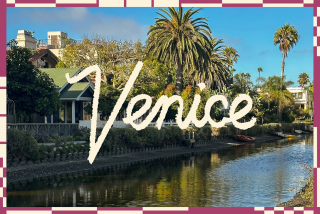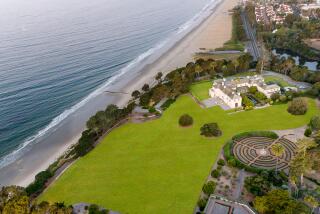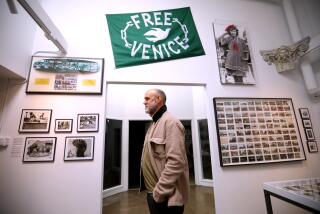Villa of civility and scorpions
- Share via
In 1987, Sally Gable decided she wanted a vacation home in New Hampshire’s White Mountains, where she had grown up. She was happily married to a lawyer, Carl, who also wrote a book about Venetian glass. They raised three children in Atlanta, were active in the arts, but the idea of a “country retreat ... where we might, in Thoreau’s phrase, ‘live deliberately,’ ” took hold. Then, reading the New York Times magazine one Sunday, she saw an ad “for a villa in the Veneto region of Italy, a villa allegedly designed by Andrea Palladio, the most influential figure in the history of western architecture.”
They consulted a book on this 16th century architect’s buildings. Of 18 surviving villas, Villa Cornaro -- commissioned in 1551 -- was one of the five largest and best preserved.
Two months later, the Gables arrived in the small town of Piombino Dese, 40 minutes from Venice by train, and were dumbstruck. The two-story, 14,000-square-foot house boasted 104 frescoes, a central salone with 24-foot ceilings, and -- unlike the disaster-prone reclamation project Frances Mayes described so humorously in “Under the Tuscan Sun” -- this home had been kept up over the centuries.
After some delays, the purchase went through fairly smoothly. One drawback soon made itself evident: Venice lies on roughly the same latitude as Montreal, and cold is no stranger to either setting. Built as a summer retreat, Villa Cornaro had only fireplaces, and their flues were blocked off long ago. Except in hot weather, keeping warm would forever be a challenge.
Other minor and major difficulties included living with scorpions, remodeling the kitchen (no sink or running water), dealing with the lawn -- the “backyard” was a small park of about an acre -- hosting outdoor concerts and installing a new roof, as well as fixing structural, plumbing and electrical problems. Repairmen always arrived with helpers, Sally notes, “ensuring that no job will be a small undertaking.” In short order, Carl, who initially spoke almost no Italian or Venetan, the local dialect, was able to ask “Quanto costa?” (how much?) like a pro.
Villa Cornaro’s role in this book is as a springboard for the couple’s varied interests. They explore other Palladian villas, finding some in good condition. Several, however, remain vacant or in disrepair, money pits no one appreciates or can afford to maintain.
Times are changing, Sally notes, when the preservation of Italy’s artistic heritage rouses so little sentiment.
Weekly jaunts to Venice allow the Gables to track down more links to the Cornaros -- the city’s “wealthiest family” built or owned 10 palaces on the Grand Canal alone -- and to study Palladio’s urban architecture.
“Piombino Dese’s market day was sanctioned by a government decree in 1790,” Sally writes, showing how this gathering is both a shopping and social occasion. Every Saturday, “90 percent of the town’s citizens spend several hours chatting, gossiping, parading, strutting.... “ The goods are sometimes no fresher than those available daily in the supermarket, but the “weekly ceremony” brings “rhythm, structure, and sense” to village life.
In one chapter, Sally pursues the perfect risotto (recipe provided), and in another, she solves the mystery of the “fugitive fungi,” white mushrooms that grow by the Gables’ poplars in autumn (the electrician and his assistants surreptitiously help themselves). There are trips to Milan and Florence, and, throughout the book, she offers small photographs and bits of history about Palladio, the Cornaro family, and Italian art and architecture. One appendix provides some neighbors’ appetizing recipes, and another suggests must-see sights for visiting Venice.
Somehow, the “spirit of the space” doesn’t quite come close. What is her “new life” in such grand surroundings really like? We get glimpses: multiple sweaters, space heaters, blown fuses, “desperately uncomfortable chairs” that look so elegant, dinner parties, new friends. But like the Villa Cornaro tours the Gables restrict to the first floor, Sally preserves her privacy. She shows and tells what’s fit for strangers to see and to hear, a charming yet proper Georgia belle.
*
Irene Wanner is a critic and the author of “Sailing to Corinth.”
More to Read
The biggest entertainment stories
Get our big stories about Hollywood, film, television, music, arts, culture and more right in your inbox as soon as they publish.
You may occasionally receive promotional content from the Los Angeles Times.










